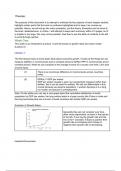Resumen
Summary Notes for Economic Growth and Institutions (Tilburg Univeristy)
- Grado
- Institución
The summary is based off ALL video lectures, slides, and readings. All derivations or time graphs that you need to know, and other concepts such as Romer model, Malthusian equilibrium, etc are in this summary. Knowing the material in this summary will allow one to confidently enter the exam and ach...
[Mostrar más]



